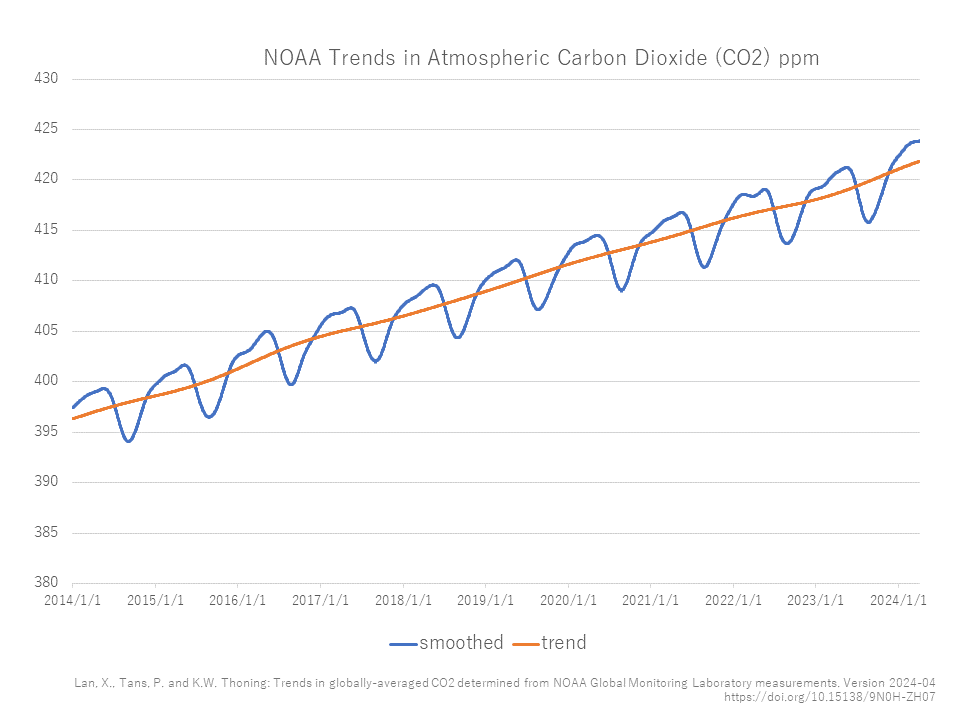Pick Up
994. Atmospheric Concentrations of Anthropogenic Greenhouse Gases Continued Steady Rise in 2023

994. Atmospheric Concentrations of Anthropogenic Greenhouse Gases Continued Steady Rise in 2023
The National Oceanic and Atmospheric Administration (NOAA) reported that the atmospheric concentrations of anthropogenic greenhouse gases such as carbon dioxide (CO2), methane (CH4), and nitrous oxide (N2O) continued its upward trend in 2023, albeit not as fast as the abnormal rates of increase observed in recent years.
Atmospheric CO2 concentrations averaged 419.3 ppm for the 12-month period ending in 2023, a 2.8 ppm increase over the previous year and marking the 12th consecutive year of an increase of more than 2 ppm per year in the past 65 years of observation history. Atmospheric CO2 concentrations are now more than 50% higher than pre-industrial levels, and the 2023 increase is the third highest in the past decade. NOAA researchers attributed these increases to a combination of emissions from fossil fuels and increased forest fires associated with the transition from La Niña to El Niño.
Atmospheric CH4 reached 1922.6 ppb in 2023. The increase in CH4 in 2023 was 10.9 ppb, which was lower than the values observed in 2020 (15.2 ppb), 2021 (18 ppb), and 2022 (13.2 ppb), but still the fifth highest since methane levels began to rise again in 2007. Atmospheric CH4 is now 160% higher than pre-industrial levels.
In 2023, atmospheric nitrous oxide rose by 1 ppb to 336.7 ppb, matching the records set in 2020 (1.3 ppb) and 2021 (1.3 ppb). The rise in atmospheric N2O in recent years has been attributed to increased nitrogen fertilizer use and composting due to agricultural expansion and intensification. N2O is now 25% higher than pre-industrial levels (270 ppb).
So far, the greatest impact on climate change has been the rise in carbon dioxide from fossil fuel burning, with anthropogenic CO2 emissions increasing from 10.9 billion tons per year in the 1960s, when observations began in Hawaii, to 36.6 billion tons per year in 2023. The current atmospheric concentration of CO2 is about the same as it was during the Pliocene Epoch about 4.3 million years ago, when the Earth was much warmer than today, the sea level was 75 feet (22.8 meters) higher, and the present-day Arctic Circle was forested (Note: The Pliocene is the geological period from about 5 million years to about 2.58 million years ago). Half of CO2 emissions are absorbed by the oceans and terrestrial ecosystems such as grasslands and forests, but the absorption of CO2 and atmospheric heat by the oceans is having a significant impact on marine ecosystems through ocean acidification.
NOAA research shows that atmospheric methane surged in the 1980s, stabilized in the late 1990s and early 2000s, and then rose rapidly upward since 2007. Studies by NOAA and NASA researchers suggest that 85% of the rise in methane from 2006 to 2021 was due to increased microbial emissions from livestock, agriculture, humans, agricultural waste, wetlands, and other water sources, with the remaining increase due to increased fossil fuel emissions. Researchers are analyzing the possibility that climate change is causing a feedback loop of increased methane emissions from wetlands.
Contributor: IIYAMA Miyuki (Information Program)
